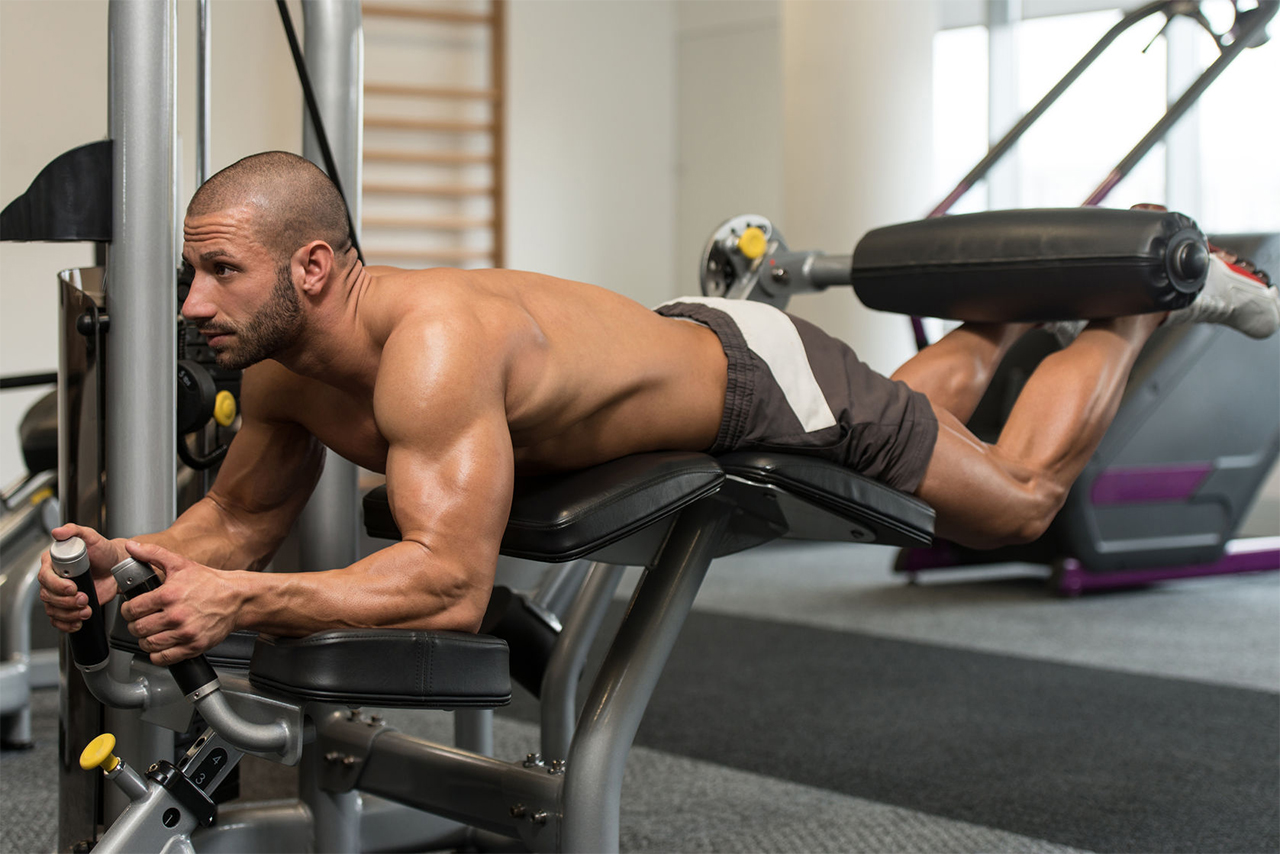If you already went through our Leg day- Quadriceps focus article, odds are, your knowledge on lower body training and structure has improved. We pretty much went through the quadriceps and calves’ anatomy briefly, giving you insights on the type of muscle fibers they are made out of.
For this second article of the series, we will give you some knowledge on the second most-lacking body part in the lower body- The hamstrings.
Hamstrings’ structure
The quadriceps’ antagonist is made out of –
- Semitendinosus and semimembranosus– The muscle fibers that make up these muscles are primarily fast
- Biceps femoris– Again, primarily fast muscle fibers
One of the main reason for many trainees’ lacking hamstring development is simply the wrong type of stimulation upon that muscle group. Due to the fact the amount of slow muscle fibers in the hamstrings is very little and insignificant, they are supposed to be trained heavily with up to 8-10 repetitions, but, not less than 6.
Many personal trainers have claimed that heavy compound movements would be enough of a hamstring stimulation, but this isn’t true, as the percentage of the tension, taken by the hamstrings during quadriceps work is not significant enough to make them grow.
This of course, implies hamstring-focused exercises.
.. But what about the abductors, adductors and glutes?
In our humble opinion, these are the muscle groups in the lower body, to which we should pay least attention, unless they are severely underdeveloped. Abductors are found on the outer side of the thighs and are primarily made out of slow muscle fibers, which of course, implies engagement during high-rep work.
Adductors are on the inner side of the thighs and are made out of:
- Adductor longus– A muscle with 60/40 slow-to-fast fibers ratio
- Adductor magnus– A muscle with 60/40 ratio
During squats (regular, hack, etc.) the adductors are highly engaged, which usually is enough of a stimulation. To engage them furthermore during squats, toes can be opened up outwards an idea more.
The glutes
This muscle group is formed out of 3 muscles
- Gluteusmaximus– The slow-fast fibers ratio here is 52/48
- Gluteusmedius and Gluteusminimus– Primarily made up of slow muscle fibers
Usually, trainees who do deep squats and enough sets of deadlifts are happy to have a properly developed glute musculature.
However, a couple of exercises to isolate the glutes will certainly be effective, as that will give the lower body musculature a more complete look, especially for the females.
Our glute exercises recommendations are at the bottom of the article.
The workout
Remember to properly warm up with light cardio, stretching and flexing before moving on to the exercises.
| Exercise | Number of Sets | Number of Repetitions | Muscle Groups Involved |
|---|---|---|---|
| Bodyweight squats | 3 | 12+ | Primarily quadriceps, secondarily hamstrings and glutes |
| Barbell high bar squats | 5 | 10 | Primarily quadriceps, secondarily hamstrings and glutes |
| Leg presses | 3 | 10 | Quadriceps, hamstrings, secondarily glutes |
| Lying hamstring curls | 6 | 10 | Hamstrings isolated |
| Barbell romanian deadlift | 4 | 6-10 | Hamstrings, glutes |
| Straight leg calf raises | 5 | 10 | Calves |
| Seated calf raises | 4 | 15+ | Outer calf musculature |
The exercises
Body-Weight Squats
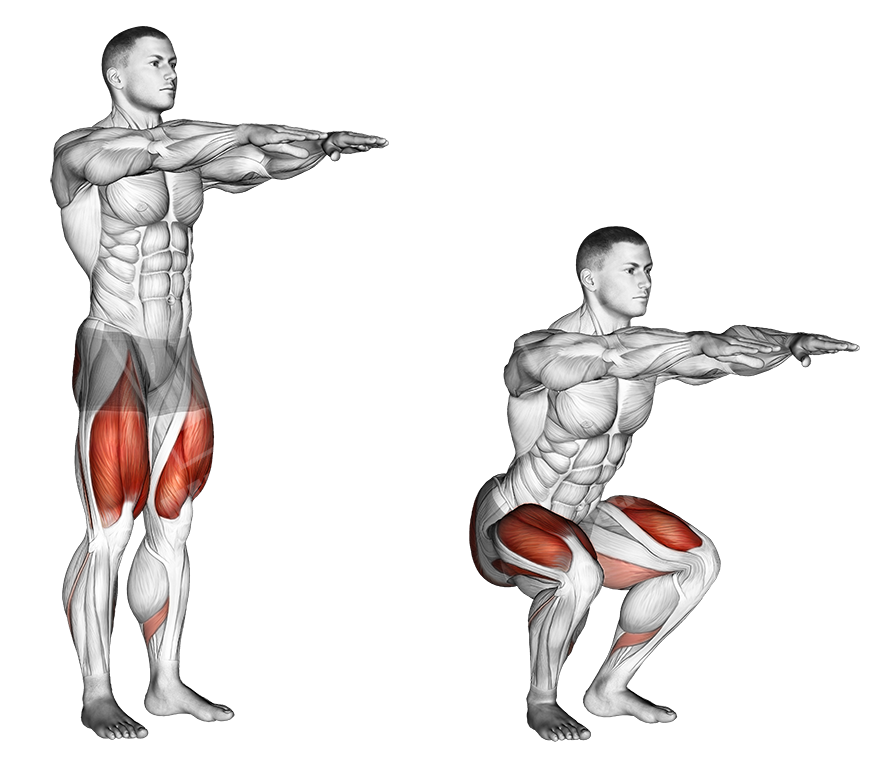
This, again, is your warm-up exercise to get you going into the workout.
Execution
- Place feet on the ground at shoulder width (if you are a taller person, consider placing them slightly wider than shoulder width)
- Make sure your toes are pointing outwards slightly and your back is straight
- Place your hands crossed on your shoulders, or keep them straight as illustrated
- Bend knees slightly so that they are not locked out
- Move down with your butt, until the point where your legs are parallel to the ground
- Squat up, driving the tension through the heels to engage the quadriceps
- Avoid knee lock out at the top of the movement, keep the knees bent and maintain as much tension as possible, upon the working lower body musculature
Barbell high bar squats
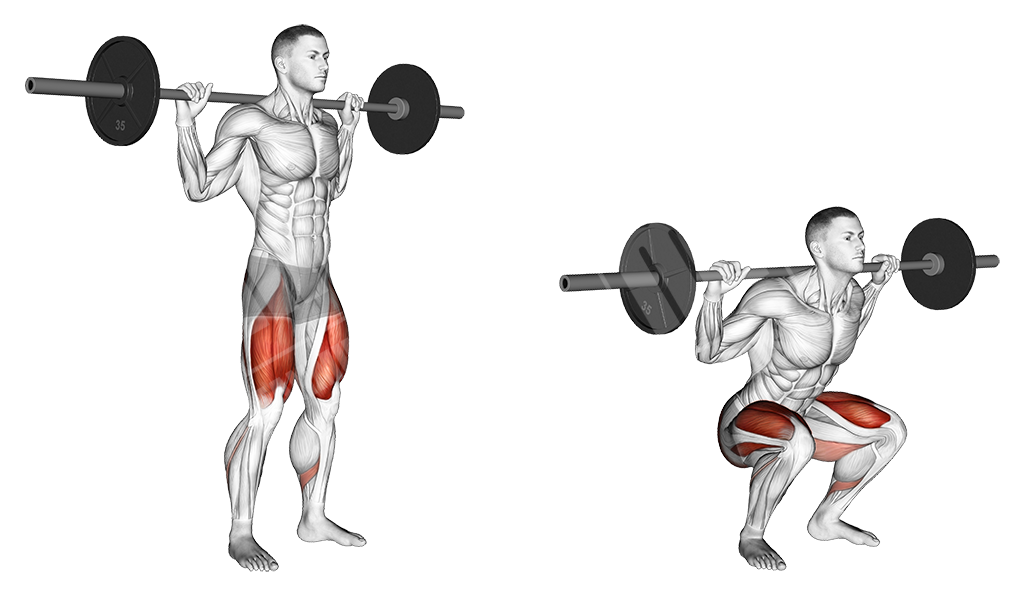
Execution
- Get under the bar and unrack it, so that it is on your trapezius and not below it
- Step with your feet at shoulder width or slightly wider if you are tall and open your toes so that they are not pointing forward
- Make sure to keep your back straight
- Move down, until legs are parallel to the ground (moving further down is optional, but if you do- make sure the movement is controlled so that you won’t bounce, as that may cause significant joint/ligament tension, which may lead to injury)
- Move up explosively, but in a controlled fashion- Keep tension on the quadriceps and DO NOT lock the knees out!
Note- Keep your body straight and don’t let it go forward too much.
Leg press
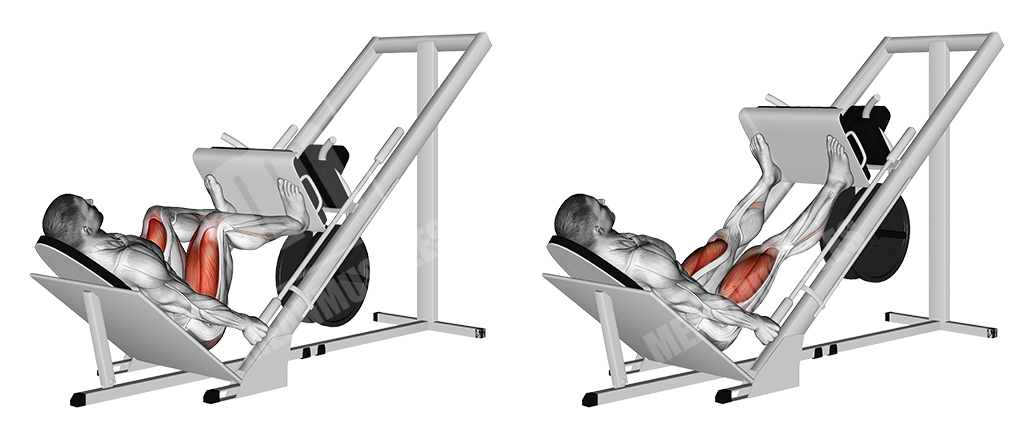
This is your next and last quadriceps-involving movement, before moving on to the hamstrings-focused exercises.
Execution
- Lay down and tuck your back and butt on the backrest and seat respectively.
- Place your feet on the platform- Wide stance, toes slightly opened outwards. Make sure your feet are higher on the platform, as this will get your hamstrings stretched and engaged more, moving into the ham part of the workout
- Avoid knee lock out
- Let the weight down slowly, then push up explosively. Again, no knee lockout
Lying hamstring curl
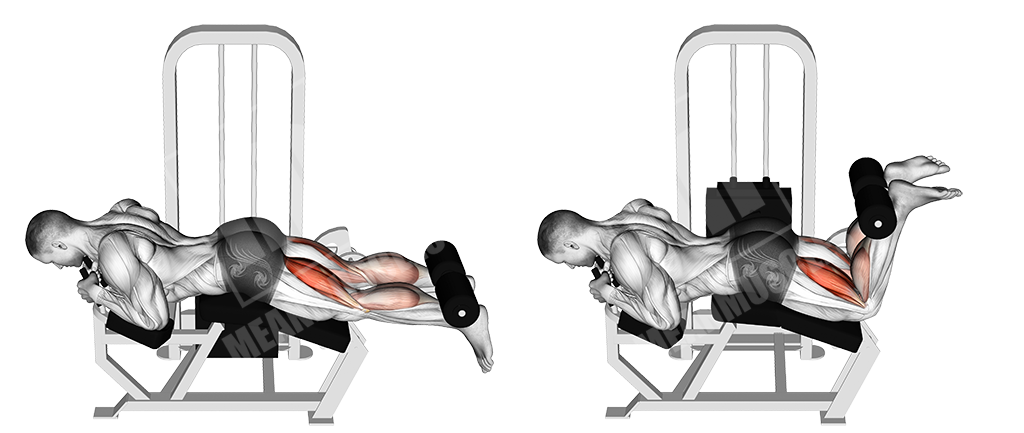
This is your first isolated hamstring movement. In our opinion, it is the best hamstring builder, as it allows for a complete, controlled contraction under a fixed range of motion.
Execution
- Lay down so that you are comfortable and place your legs under the pads- The pad is supposed to come right above the heel, and the legs are supposed to be at shoulder width
- Get grab of the handles with your hands so that you are stable
- Curl slightly to activate the hamstrings and keep the tension on them
- Curl up, until full hamstring contraction, then hold it for a split second
- Slowly let the weight down, while still keeping constant tension on the working musculature- Don’t let the weight down completely (weights shouldn’t touch the whole stack at the bottom)
Note – Avoid having the pad touch your butt at the top of the movement.
Barbell Romanian deadlift
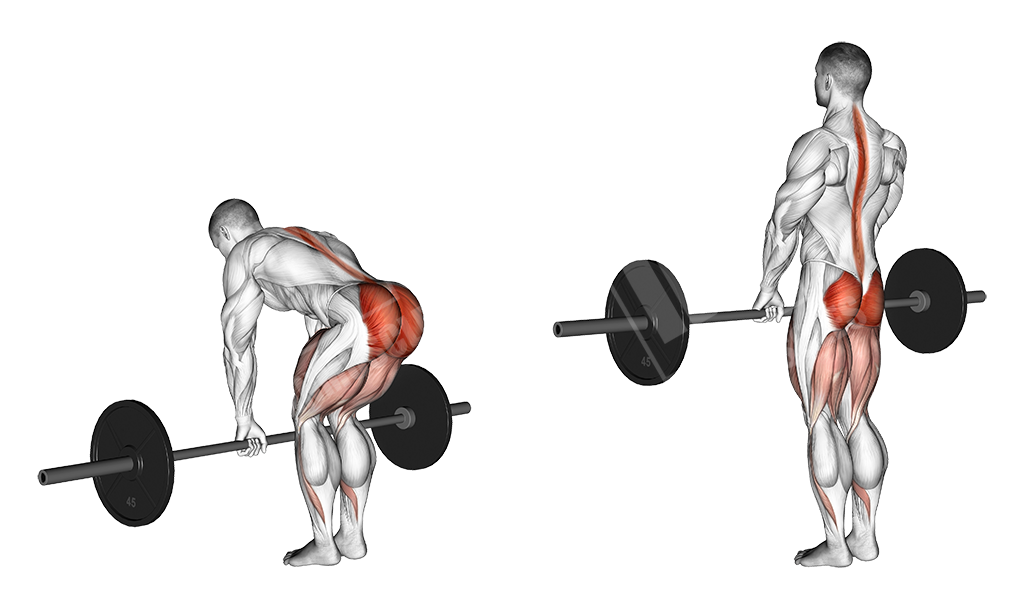
For those of you who are fans of this exercise, we will note here that it significantly engages the middle/lower back but is also almost entirely completed with a hip extension, which, of course, is a function of the biceps femoris.
This is a more advanced exercise, as it requires significantly bigger coordination, meaning you should take it easy on the weights if you are a beginner. This exercise is extremely helpful as it improves the CNS’s efficiency and syncs the different muscles, engaged during a complex movement like the deadlift.
Execution
- Load the bar and place it in front of you, on the ground (remember- DEADlift, you are lifting the weight from a dead position, racks are not accepted.)
- Lean down and grab the bar at shoulder width
- Keep the knees slightly bent, so that they are not locked out
- Keep the back straight and head looking forward
- Tense the hamstrings
- Lift the bar up, contracting the glutes at the top
- AVOID overextending with your back on the way up- Number one cause of lower back injuries
- Let the weight down slowly, feeling your hamstrings stretch. DO NOT let the weight down completely, resting on the ground, as that will take away the tension from the hamstrings
Glute exercises
As we mentioned early on in the article, two exercises for the glutes will certainly help you develop a more complete lower body.
Our two best picks for gluteus exercises consist of one heavy movement, done in the ~10 rep range – Hip thrusts.
And one light movement- Glute kickbacks, done in the 15~25 rep range.
The Exercises
Barbell Hip Thrusts
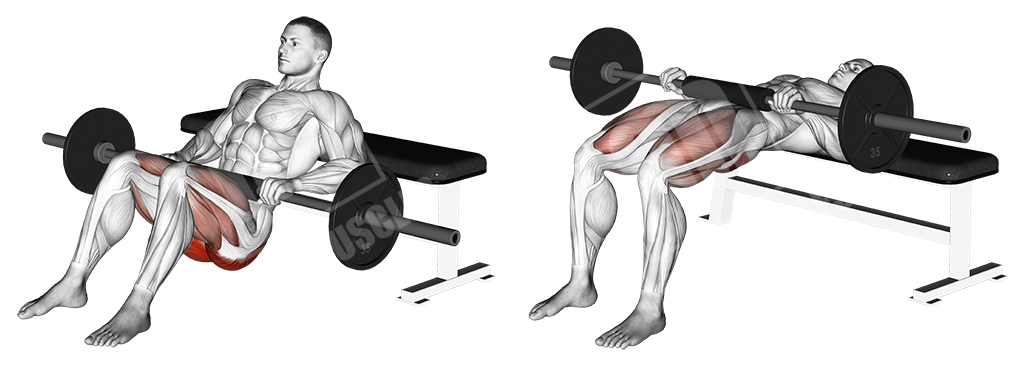
In our opinion, this is the best glute builder.
Execution
- Place the barbell on the side of the bench
- Lay under the bar, with your upper back on the bench
- Place a pad on the barbell so that it is not uncomfortable
- Move feet forward at shoulder width as illustrated
- Thrust the weight up, contracting your glutes
- Hold contraction at the top for a split second
- Let the weight down slowly
Straight Leg Glute Kickbacks

This exercise is either done with a cable attached to your ankle, or without any weight at all- the point here is to, again, get optimal glute contraction.
Execution
- Kneel down and place your hands on the ground as illustrated
- Keep your back straight
- Lift one of your legs up in a straight position
- Kick up, contracting the glute
- Let your leg down
- Move on to the next contraction on the same side
- After completing the given number of reps, move on to the opposite side (E.g.- Left side- 25 reps, right side 25 reps)
Calf exercises
Is it enough to train legs once a week?
This is a commonly asked question. The answer to it is simple- Training any muscle group once a week would be enough to maintain what you have gained. However, if the goal is optimal muscular development, the workout split MUST be structured so that the musculature is trained twice a week.
Usually, the most general advice for lower body training, which you will get, whether it is from fitness magazines or online, is training legs with a big load of volume, which is often more than 40 sets, once a week. However, such approach to training is not effective for optimal muscle growth, especially for natural athletes. When working out, the protein synthesis in the musculature increases a couple of times. Afterwards, the levels of it remain elevated for at least 48 hours.
On the flipside however, the central nervous system’s recovery takes a bit longer- Around 72 hours. Doing a weight workout again, before those 72 hours will be highly ineffective and may even result in negative effect upon strength levels. This simply means that the best benefit from consistent workouts can be gained if we train the legs every 4 days or so. The volume of the workout of course, is in accordance with the increased frequency of the workouts.
The recommended beginners’ workout plans include 1 compound movement, 1 assisting movement, 1 hamstrings movement and one calf movement. However, the approach for intermediate and advanced athletes is quite different, as they have to give themselves an objective opinion for the lacking parts of their lower body musculature and prioritize them.
So, for example, if you’ve been training for some time now but your hamstrings are lacking, compared to the quadriceps, then using a workout like the one presented above would be rational. You should remember that the perfect training plan doesn’t exist, but it can be created, if we pick the correct exercises, sets and reps, in accordance with our individual characteristics, more and less developed muscle group.
If you liked our articles on lower body training so far, make sure to let us know how they worked for you.

